HOW TO SET YOUR GOALS FOR THE YEAR
For a lot of people, January means coming up with resolutions for the year ahead. However, these promises are sometimes left unfulfilled or discontinued — only to be recycled the next year.
To beat this cycle, you need to stop looking at them as resolutions and see your list as actionable goals. And in order to act on everything in your list, you need a plan. Goal-setting is your strategy or plan of action to achieve the results that you have in mind.
But how does one set goals? Read on to find out.
PART 1: REVIEW
Thinking of the possibilities and goals for the new year is exciting, but it’s important that you review the past year first.
Reflecting on everything that happened last year is the crucial first step for goal-setting. It helps you trace patterns and habits. You also get to see the root causes of you achieving (or failing to achieve) your goals.
1. Begin your review by listing your basic growth categories
These are the areas of your life that matter to you. They can be quite general or as specific as you need them to be. Examples of growth categories are:
Self (health, finance, art, travel)
Relationships (family, friends, romance, networks)
Professional Growth (technical or soft skills, projects, promotions, experiences)
Personal Advocacies
2. Next, list down all your achievements in each growth category, per month
For example, in January, you achieved P5,000 in savings (self), met up with old friends (relationships), and got promoted at work (professional).
3. Then, list down all your failures or uncompleted tasks in each growth category, per month
Examples of these can include missing a reunion, not finishing a painting, or passing up an opportunity to support your advocacy.
4. After this, analyze your list. Check for trends and patterns
Ask yourself questions such as:
What is the common thing that held me back from achieving my goals? Did I lack discipline or good habits?
What were the things that made me feel fulfilled and happy?
Where did I spend most of my time?
Is everything I did aligned with my long-term goals?
Did I spend time with people who helped me achieve my goals? In the future, do I need to spend more time with friends, or expand my network?
What do I need to CONTINUE, START, and STOP doing next year?
Look at how your past year adds up. Are you happy and satisfied? Or do you wish you could have done more? Since the year has come and gone, the good news is that you can now RECALIBRATE and prepare yourself for a bigger, better year.
PART 2: RECALIBRATE
Now that you have a better view of where you’ve been and how far you have to go, it’s time to write down your game plan for the year!
5. List all your goals for this year
Don’t overthink — just do a ‘brain dump’ of everything that you want to achieve. You can use the CONTINUE, START and STOP formula as a basis for this list.
6. After you’ve written down all your goals, it’s time to prune and purge your list
Focusing on a few important goals is better than committing to a number of goals that you won’t be able to accomplish.
One tip for shortening your list is to follow the Pareto Principle. This means looking at the 20% of your tasks that affect 80% of your results. Commit to prioritizing this top 20%.
Before you finish your list, ask yourself if these goals are SMART: Specific, Measurable, Attainable, Realistic, and Time-bound.
For example: “Get fit” isn’t a SMART goal. A better way of saying this would be “Lose 24 pounds in 1 year.” See the difference? This makes this goal specific, measurable, attainable, realistic, and time-bound.
7. Break your big goals down into small steps and milestones that you need to hit per quarter or per month
Taking our example from earlier, losing 24 pounds in 1 year may seem overwhelming. But you only need to lose 2 pounds per month!
8. Develop a strategic plan or habit system to follow this year
Now that you know what you need to do, you need to figure out how you plan to do it. What habits should be part of your daily, weekly, and monthly routines? You can put your plan or habit system into a formula such as this:
GET (yourself)
TO (do an action / achieve a goal)
BY (doing these steps)
Taking the example above, you could say that this year you plan to:
“Get myself to lose 24 pounds by saying no to junk food.”
“Get myself to lose 24 pounds by exercising 2x a week (going to the gym on Thursdays and Saturdays).”
9. Schedule and track your habits
At this point, you’ve gone from a general resolution of ‘get fit’, into manageable habits that are perfect for scheduling in your new planner! Remember: what doesn’t get scheduled, doesn’t get done. You can use a traditional planner or calendar, or use task management apps to help you remember all that you need to do every day, week, or month. This also reduces the need to remember these new habits, on top of your current to-dos. By integrating these habits into your schedule, you integrate all of your yearly goals into your life.
10. Review and monitor your progress regularly
Make sure that you follow-through on your resolutions by documenting your progress and reviewing your results weekly, monthly, or quarterly. By checking up on how you’ve done throughout the year, you get to see how far you need to go and what else you have to do to achieve your goals.
Once you’ve finished goal-setting, you’re all SET for the year ahead! This exercise makes your plans concrete, achievable, and less tempting to drop halfway through January. You can even apply this process to various areas of your life, like your business or workplace.
YOU MAY ALSO LIKE
Vitalstrats Creative Solutions (VCS) is a creative agency based in Quezon City, Philippines. VCS specializes in content marketing, advertising, and video production. We use strategic creativity to help our clients grow their brands.
Facebook: https://www.facebook.com/vitalstrats
Instagram: https://www.instagram.com/vitalstrats
Twitter: https://twitter.com/Vitalstrats
Agency Reel: http://bit.ly/VCSReel2019
At VCS, we believe that growth should be strategic and purposeful — not accidental. Thus, goal-setting (or strategic planning) is at the core of our yearly preparations. This shared vision guides us and gives us solid benchmarks on which to measure our success.
Are you going to try this goal-setting exercise? Or do you have other ways of preparing for the year ahead? Let us know in the comments below!




